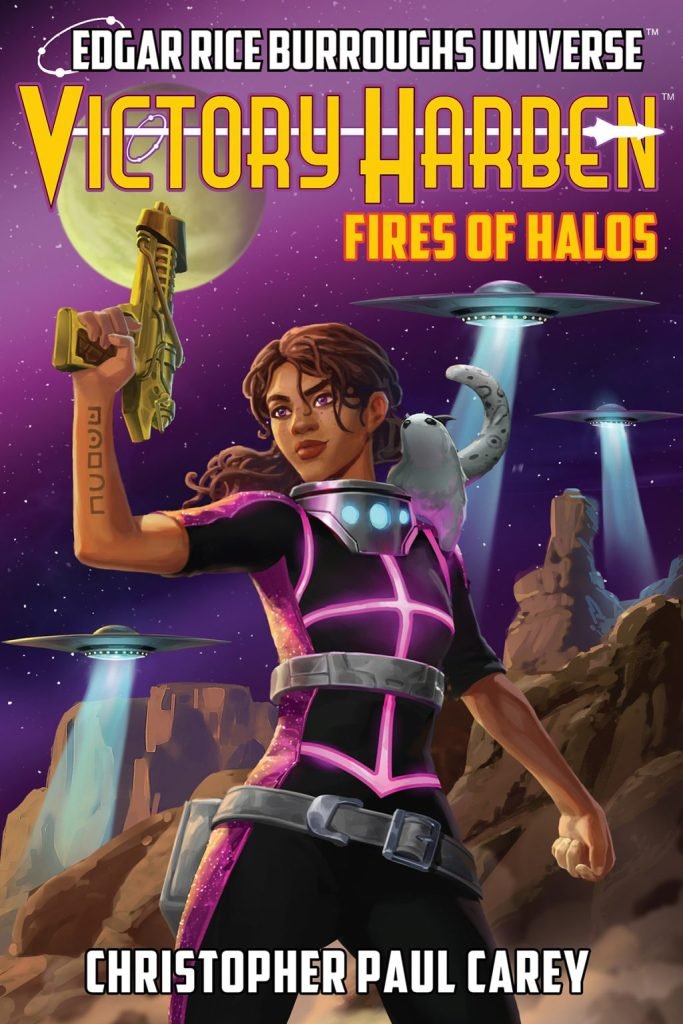TITLE: Korak at the Earth’s Core (Dead Moon Super-Arc #1)
AUTHOR: Win Scott Eckert
306 pages, Edgar Rice Burroughs, Inc., ISBN 9781945462634 (hardcover, softcover, collector’s hardcover)
MY RATING: 5 stars out of 5
MY THOUGHTS: Win Scott Eckert returns to the world of Pellucidar with his latest novel in the Edgar Rice Burroughs Universe (ERBU) series, Korak at the Earth’s Core. This new installment is every bit as action-packed, immersive, and character oriented as Eckert’s Tarzan: Battle for Pellucidar, and while it picks up some subplot threads from that novel it is the start of a new storyline. It also begins to address a number of questions the Master, Edgar Rice Burroughs, left unanswered in the original Tarzan and Pellucidar novels, including the mystery of life on Pellucidar’s stationary pendant moon as well as what Philip Jose Farmer called “the Great Korak Time Discrepancy.”
The action takes place about twenty years after Tarzan: Battle for Pellucidar. Tarzan’s granddaughter, Suzanne, has been living in Pellucidar since the events of that book, has taken a mate and had a child – and has gone missing in the Land of Awful Shadow underneath the pendant moon. Korak and Meriem, Suzanne’s parents, immediately (but separately) head to the Hollow Earth to search for her. Eckert wonderfully juggles chapters from both characters’ perspectives as their searches take them across the breadth of Pellucidar. They encounter a variety of familiar and new deadly Pellucidarian wildlife and equally dangerous new civilizations, and Eckert details the battles with his usual distinct action style. Quite a few pulse-pounding moments for both characters, as well as for the crew of the airship O-220.
But what I really appreciated about the book is Eckert’s focus on the two main characters, and how they are both similar to and different from their predecessors.
Korak may be the son of Tarzan and have his father’s survival skills and enhanced strength and love of wildlife – but he is NOT his father in terms of temperament and life experience. Eckert draws on Korak’s childhood abandonment issues and his adult experiences as a soldier in World Wars One and Two to create a complex exploration of the Post-Traumatic Stress Disorder (PTSD) that so many of those who experienced childhood neglect and/or wartime service have suffered from. Korak’s PTSD, which has been under control for years, comes roaring back while he is in Pellucidar, and Eckert hints at complexities that I’m sure will be explored deeper in this book’s sequels.
Likewise, in some hands Korak’s wife Meriem could simply be portrayed as “Jane Porter redux.” But she is so much more than that. Both are strong-willed women who are the equals of the men they love, capable of taking charge of situations and surviving harsh environments. Neither woman is so in love with their men that they are blind to or forgiving of their spouses’ foibles; for instance, when they learn of Suzanne’s disappearance, Korak and Meriem are at separate places on the surface world and Korak charges off to Pellucidar without his wife. Meriem eventually forgives, but does not forget, his rash hotheadedness. Meriem’s survival skills are different from Jane’s, thanks to their different upbringings, and come well into play in Meriem’s chapters.
Ultimately, Korak and Meriem and the characters traveling with them (and oh, I could probably write an essay on those supporting characters and how they enhance the narrative; I will simply say it’s a joy to see Suzanne’s mate Lordan again, and to see ERB’s Betty Calwell playing an ongoing major supporting role across the new ERBU books) come together for the novel’s dramatic denouement. The final scenes of the book tie the subplots of the novel together but still leave some questions to be answered – which makes sense as this is the start of a new trilogy, the “Dead Moon Super-Arc.” I am excited to see where Eckert takes Korak, Meriem, Lordan, Akut, Betty, and the rest in the second installment.
The book also comes with a bonus novella written by ERB Inc. Vice President of Publishing Christopher Paul Carey, “Dawn of the Deathslayer.” This novella stars Janson Gridley, another second (or is it third?) generation character introduced in the previous ERBU series (the “Swords of Eternity Super-Arc”) who I’ve been hoping to see more of. Janson explores another previously unexplored part of Pellucidar and meets a new character, Darva the Shadow, and her tribe. The novella does a wonderful job bringing in this new character and giving us insight into where Janson Gridley has been since his experiences in the novel Victory Harben: Fires of Halos. I’m looking forward to seeing both characters turn up in future ERBU novels. Maybe they’ll even get a book of their own at some point.
I received an advance reading pdf of this book for free from the publisher in exchange for an honest review. This does not affect my opinion of the book or the content of my review. Korak at the Earth’s Core publishes in late March and can be pre-ordered on the publisher’s website.




